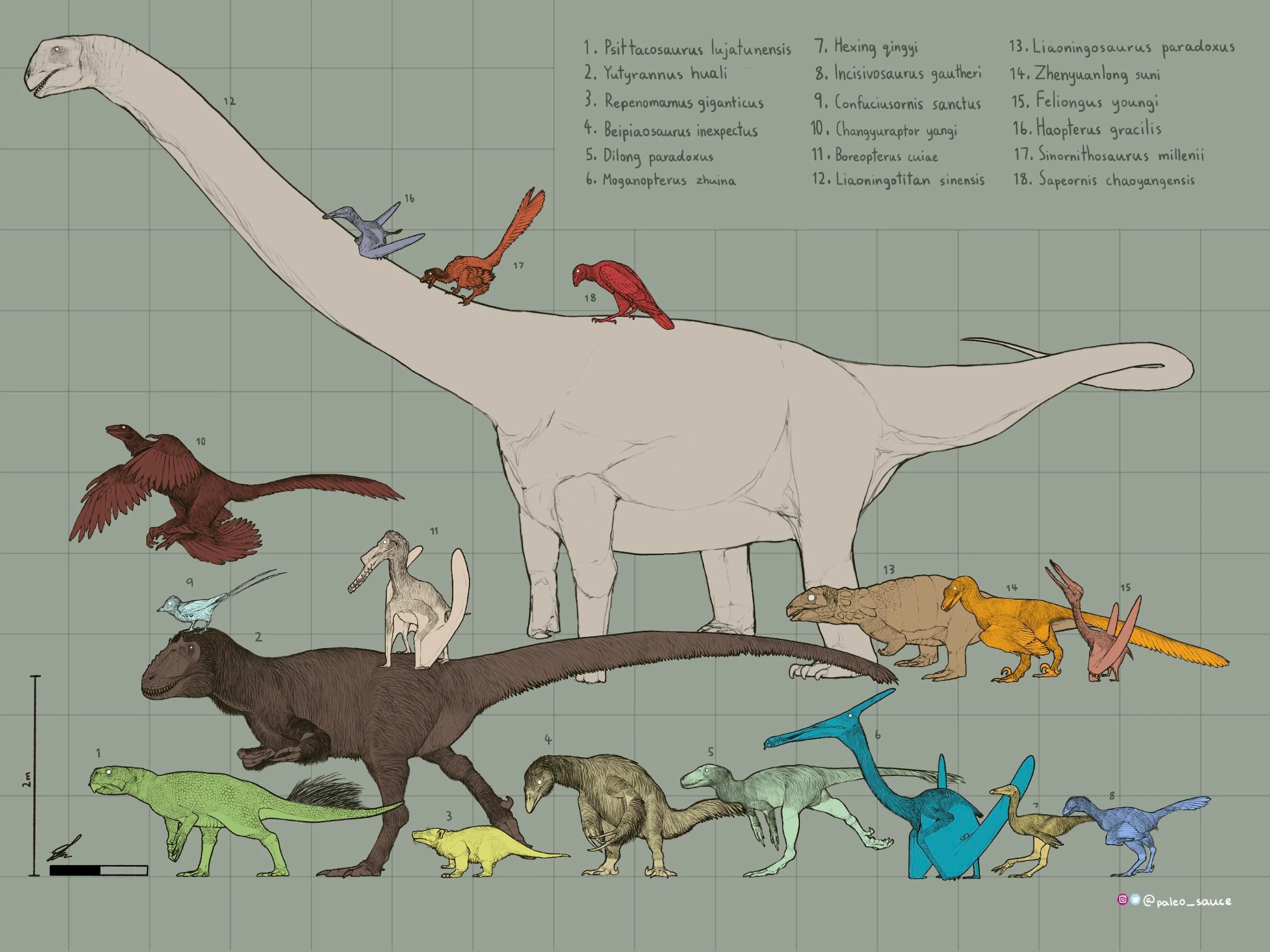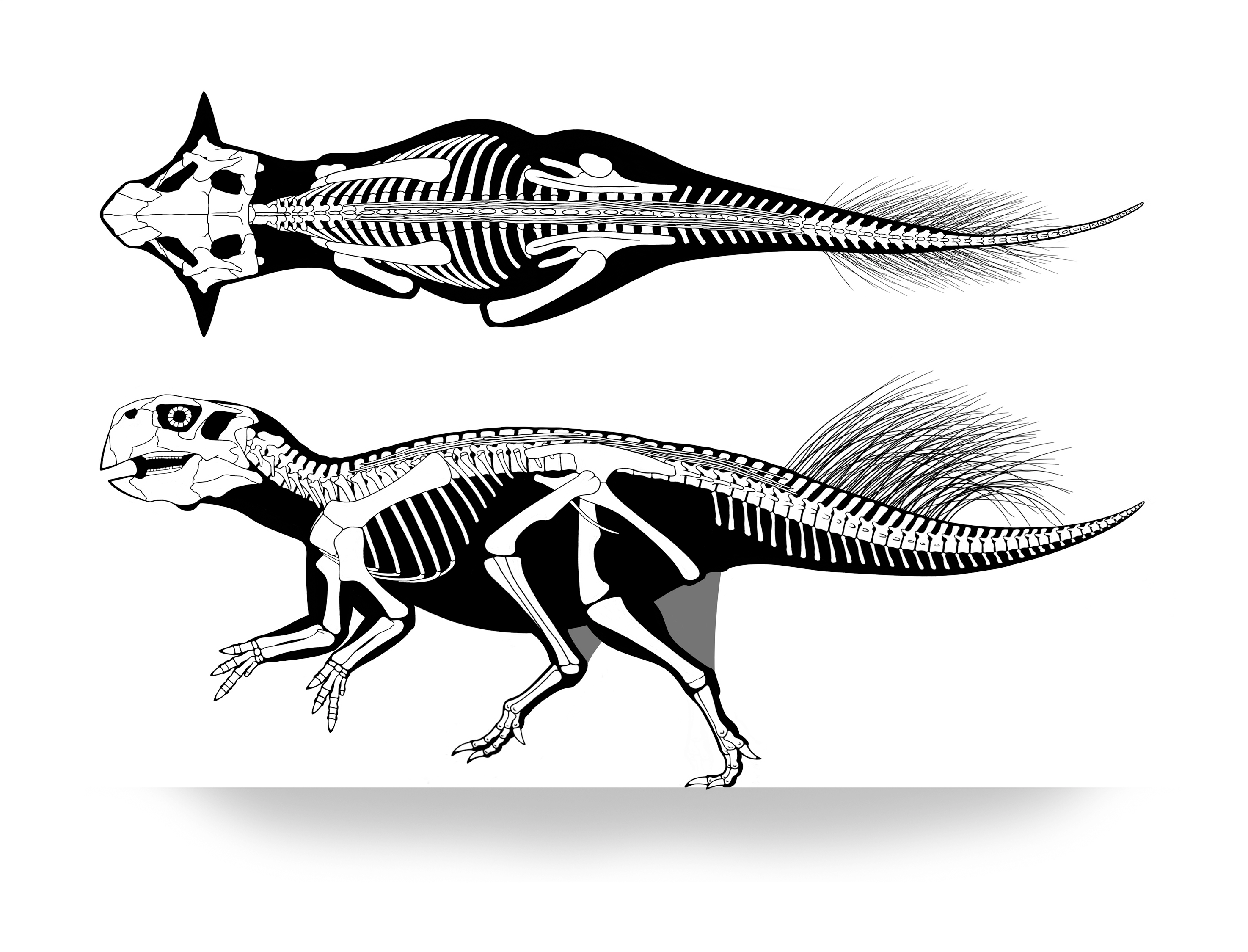First and foremost, here's a size comparison of
P. lujiatunensis and
R. giganticus (the larger of the two species of
Repenomamus) (
this-> is the artist).
 Psittacosaurus
Psittacosaurus holds a clear size advantage. While weight estimates vary, I have seen figures up to nearly 40 kg for this particular species. Looking at the size of
Psittacosaurus in the size comparison above, weights of 37-38 kg don't seem too unlikely to me.
Zhao et al. (2013)Erickson et al. (2009)Repenomamus giganticus weighed some 12-14 kg (
Prothero, 2017). This would be congruent with the claim that adult
Psittacosaurus would be twice the size of
Repenomamus (
Lomax & Nicholls, 2021).
Apart from size, I also think
Psittacosaurus had a number of physical defenses to its disposal. First, the jugal horns were pretty large and look really formidable, based on the now well-known
Psittacosaurus sp. specimen that exquisitely preserves soft tissue (
SI info of Vinther et al. (2016)). It could try striking/stabbing the
Repenomamus with these jugal horns.

Second, the reconstruction above also seems to suggest the pedal unguals (foot claws) were more pointed and claw-like than the hoof-like nails of more derived quadrupedal ceratopsians. Lo and behold, the pedal unguals of
P. sibiricus are described as claw-like (
Averianov et al., 2010). So while they weren't specialized weapons, their claw-like, pointed shape could still be damaging when used to kick like a modern ground bird (it's worth noting that in ground-dwelling birds, the claws don't need to be actual specialized weapons to be used for kicking; everything from emus to cassowaries will kick, and even emus, with plain feet, can potentially cause serious injury with their foot claws).
Third, the forelimbs of
Psittacosaurus may have had some use in grabbing and carrying objects (like vegetation) so long as they were underneath its belly, which
Repenomamus conveniently is (although, at least based on this analysis that does not account for articular cartilage, it probably could not bring things to its mouth) (
Senter, 2007). Available manual unguals (finger claws) are also described as pointed rather than hoof-like (Zhao et al., 2013). So I think it's likely that
Psittacosaurus could literally grab a
Repenomamus trying to attack it from underneath.
Fourth,
Psittacosaurus had a powerfully built skull that could bite hard. The beak had a rounded tip instead of a hooked and pointed one, limiting the kind of damage it could do, but it could probably still be damaging based on sheer force. When the upper and lower beak were aligned, the beak would have a shearing and cropping function (primarily for vegetation, but maybe it could cut through the skin and flesh of a mammal less than half its weight?). When the lower beak was retracted such that it was inside the upper beak, it would take on a crushing function (so maybe it could crack the bones of a much smaller animal if it tried) (
Sereno et al., 2007).
Lastly,
Psittacosaurus had stupidly thick, tough skin for an animal of its size. It is 10-15 mm thick (
Lingham-Soliar, 2008).
To put this into perspective, a freaking elephant has skin 10-15 mm thick on the sides and back (
Shadwick et al., 1992).
The fact that
Psittacosaurus had skin comparable in thickness to that of an elephant, an animal literally two orders of magnitude larger than itself (and often touted for having tough, thick skin, although elephant skin is actually about as thick as expected for an animal of its size) is utterly astounding. Furthermore, it contained numerous layers of collagen fibers arranged in a way that made the skin very tough. This is thought to be an adaptation against predators, similar to the nurse shark's highly thickened and reinforced skin (Lingham-Soliar, 2008).
Now, what about
Repenomamus? Gobiconodontids were carnivorous Mesozoic mammals, and the robust jaws and teeth of taxa like
Gobiconodon and
Repenomamus could be used to deliver a powerful bite, perhaps even allowed for some degree of bone crushing. The procumbent incisors were designed for piercing or grasping.
Gobiconodon was described as having a "bearlike build" (
link->), so these mammals were also powerfully built predators too.
Overall, I think an adult
Psittacosaurus, with its numerous potential (co-opted) weapons, thick skin, and >2-fold greater body mass would be able to best a
Repenomamus most of the time. In fact, it appears
Psittacosaurus' growth patterns suggest that upon reaching a certain age/size, predation pressure was greatly diminished (Erickson et al., 2009), consistent with the idea that an adult
Psittacosaurus would probably be out of reach for
Repenomamus for the most part (although, the part that says that there were no predators that could indisputably prey on adults is by now outdated;
Yutyrannus could easily prey upon any
Psittacosaurus).